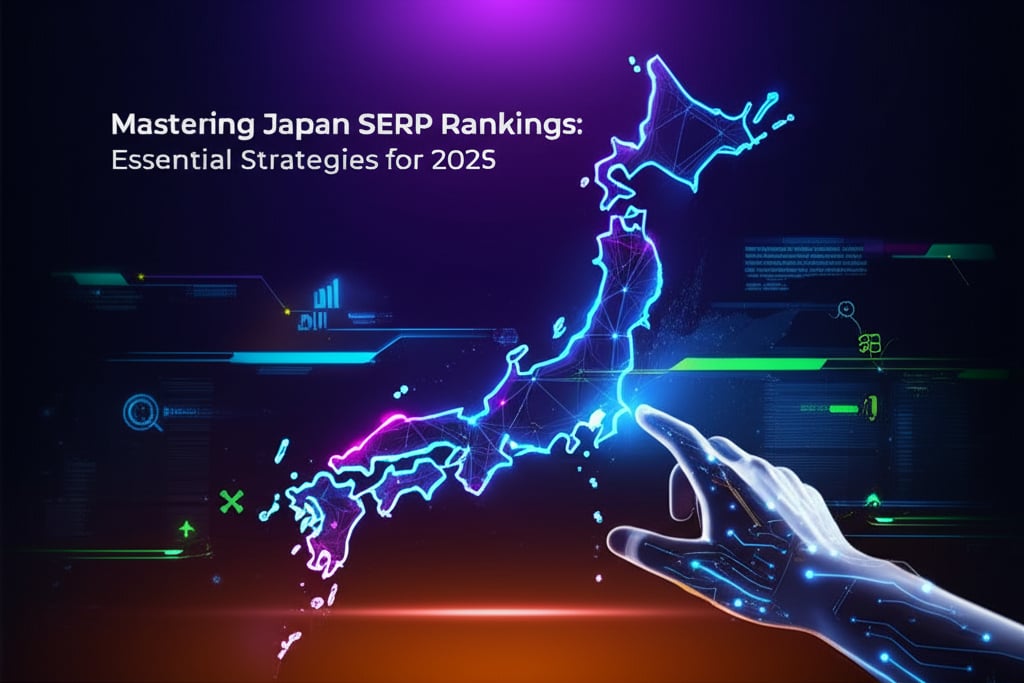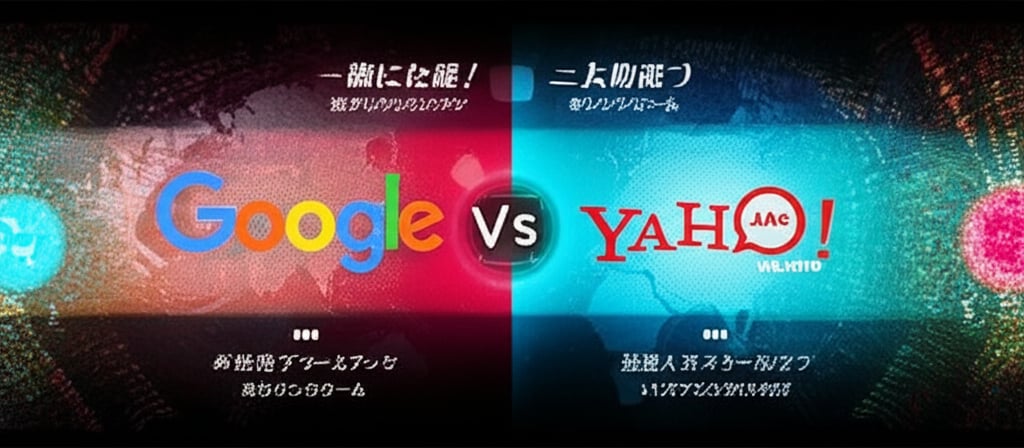Mastering Japan SERP Rankings: Essential Strategies for 2025

Embarking on a quest for robust online visibility within the intricate digital realm of Japan is not a straightforward journey; it presents a mosaic of distinct challenges for businesses. While the global titan, Google, undeniably holds a commanding share, often cited as exceeding 82% of the search market, its dominance is not absolute or unchallenged. The enduring power of Yahoo! Japan, which remains a formidable player particularly among specific demographics and in certain content verticals, coupled with the burgeoning trend of voice search, collectively compels businesses to adopt a strategy that is not merely diverse but intricately sophisticated. This requires a finely tuned, multi-pronged attack on the digital front, moving beyond conventional methodologies. Neglecting these specific market characteristics can erect substantial barriers, as anecdotal evidence from online forums and industry reports frequently highlights businesses struggling to gain meaningful digital traction despite pouring resources into standard SEO endeavors.
This comprehensive guide is meticulously crafted to illuminate the pathways to achieving premier search engine rankings in Japan by 2025. It aims to furnish you with indispensable strategies, ensuring that your digital footprint authentically resonates with the highly discerning and technologically astute Japanese audience, fostering genuine connection and sustained online success.
Deconstructing Japan's Singular Search Market Dynamics

The Japanese search engine ecosystem stands as a curious outlier in the otherwise homogenized global digital landscape. While Google’s overarching presence broadly aligns with worldwide patterns, Yahoo! Japan steadfastly maintains a notable stronghold. This is particularly evident amongst older generations and within specialized sectors such as news dissemination and e-commerce. This pervasive dual-platform reality unequivocally dictates that a generic, 'one-size-fits-all' global SEO blueprint is inherently inadequate and destined for suboptimal results. Detailed industry analyses consistently indicate that even though Google's algorithm underpins much of Yahoo! Japan's organic search results, the platforms exhibit profoundly distinct user behaviors and integrate proprietary services that necessitate bespoke optimization efforts.
Consider, for instance, Yahoo! Japan’s strategic integration of its unique services directly within its core search results. Prominent examples include Yahoo Shopping, a bustling e-commerce hub, and Yahoo Chiebukuro, a highly popular Q&A platform boasting an impressive user base of 52 million individuals, akin to Western counterparts like Quora or Reddit. These deep-seated integrations mean that users are frequently guided and retained within Yahoo’s proprietary ecosystem, underscoring the critical importance of optimizing your presence not only for general search but also for these influential sub-properties. Furthermore, while Microsoft's Bing holds a comparatively smaller overall market share, it commands a noteworthy 16% on desktop devices. This often stems from its default status on Windows operating systems, making it a viable and sometimes crucial consideration for business-to-business (B2B) ventures. The overarching principle here is that a profound understanding of who utilizes which platform, and for what specific objectives, serves as the bedrock for crafting a truly strategic and effective digital approach.
Key Takeaway: Japan's search market is a sophisticated tango between Google's robust algorithmic prowess and Yahoo's deeply integrated service ecosystem, unequivocally demanding a meticulously dual-focused SEO strategy.
The Mobile-First Imperative and Core Web Vitals in Japan

Japan stands as an undeniably mobile-first nation, a digital landscape where the smartphone reigns supreme. A staggering proportion—over 70%—of all search queries originate from mobile devices, a figure underscored by an astounding 93% smartphone penetration rate across the populace. In this environment, Google’s mobile-first indexing isn't merely a strategic recommendation; it acts as an absolute, non-negotiable prerequisite for achieving any semblance of ranking success. Websites that falter in their mobile performance are subjected to severe algorithmic penalties, which directly translate to diminished visibility and a fragmented, frustrating user experience.
Attaining stellar scores—ideally soaring above 90/100—in Google's Pagespeed Insights tool for Core Web Vitals is not just advisable; it’s an operational imperative. This critical performance metric encompasses several key components. Foremost among them is optimizing Largest Contentful Paint (LCP), which precisely measures the time elapsed until the primary content element on your page becomes fully visible to the user. Given Japan's widespread adoption of advanced 5G mobile networks, users have cultivated an expectation for instantaneous loading times. A significant step towards bolstering LCP involves meticulously optimizing hero images to remain under 100 KB in file size and converting them to modern, highly efficient formats like WebP format. Furthermore, ensuring a buttery-smooth Cumulative Layout Shift (CLS) and minimal First Input Delay (FID) collectively delivers an impeccable, seamless user experience. Such a refined experience is increasingly becoming a paramount factor that search algorithms prioritize when determining organic rankings, acting as a direct reflection of a site's overall quality and user-centric design.
Optimizing for Mobile-First Indexing Japan: A Strategic Blueprint:
- Responsive Design Mastery: Implement a meticulously crafted, fully responsive web design. This design must possess the innate ability to adapt flawlessly and dynamically to the vast array of diverse mobile screen sizes and orientations, providing an optimal viewing experience regardless of device.
- Aggressive Image Optimization: Undertake rigorous compression of all images, paying particular attention to large, visually impactful hero images. The goal is to reduce their file size to less than 100KB, leveraging highly efficient, next-generation image formats such as WebP. This ensures rapid loading without compromising visual fidelity.
- Concise Title Tag Length: For mobile meta titles, brevity is key. Aim for succinctness, targeting approximately 28 characters when utilizing full-width Japanese characters. This precise length prevents undesirable truncation within the search engine results pages (SERPs), ensuring your message remains intact and impactful.
- Enhanced Font Readability: Prioritize the use of sufficiently large, exceptionally clear, and easily discernible fonts. This is particularly crucial for content rich in Kanji characters, where complex strokes demand excellent legibility on smaller screens. The objective is to ensure effortless readability and comprehension for the user.
- Minimizing Intrusive Elements: Proactively avoid the deployment of disruptive pop-ups or overly aggressive, sticky elements. These often obstruct the primary content and significantly degrade the mobile user experience, leading to frustration and potential abandonment. A clean, unobstructed interface is paramount.
Key Takeaway: Uncompromising mobile optimization and unwavering adherence to the stringent Core Web Vitals are not merely beneficial; they are absolutely non-negotiable for achieving and sustaining organic visibility within Japan's intensely mobile-centric digital landscape.
Linguistic and Cultural Dimensions of Japanese Keyword Strategy
The Japanese language, with its multifaceted and intricate four-part writing system—comprising Kanji characters, Hiragana characters, Katakana characters, and Romaji terms—presents a profound and unique challenge for effective SEO. A simplistic, direct translation of keywords from English to Japanese is, more often than not, woefully insufficient. This is because each distinct script can imbue the same conceptual term with varying nuances, convey different user search intents, and command wildly disparate search volumes. For instance, the exact same word can have different search volumes and implications depending on whether it's written in Hiragana (phonetic, often used for native words and grammatical particles), Katakana (phonetic, commonly used for foreign loanwords and emphasis), or Kanji (logographic, conveying meaning directly). A word like "coffee" might be searched primarily in Katakana (コーヒー), while a traditional concept might be exclusively in Kanji.
Mastering Japanese Keyword Research and Optimization: A Comprehensive Approach
- Script-Specific Keyword Research: Beyond fundamental keyword research, it's essential to conduct in-depth investigations across all major Japanese scripts. Tools like Ahrefs, Semrush, or even Google Keyword Planner (when configured for Japan) can provide initial insights. However, the true mastery lies in understanding the cultural and contextual implications of each script. For example, a search for "sushi" might see variations across scripts, and understanding which script implies a local search, a historical inquiry, or a desire for a recipe is critical. This approach allows for the identification of high-volume, high-intent keywords that a simple translation would miss.
- Leveraging Yahoo! Japan Data: Do not underestimate the value of Yahoo! Japan for keyword insights. Its user base, particularly older demographics, often utilize different search terms or phrases compared to Google users. Exploring Yahoo! Chiebukuro (Q&A platform) can uncover natural language queries and common problems, providing an invaluable reservoir of long-tail keywords and understanding public sentiment around certain topics.
- Understanding Search Intent nuances: Japanese users often exhibit very specific search behaviors. For instance, they might prefer highly detailed, informational queries rather than short, direct ones. The concept of "omotenashi" (wholehearted hospitality) extends to digital interactions, implying a desire for comprehensive, helpful content. Research tools must be used with a keen eye for these cultural inclinations.
- Voice Search Optimization: The rise of voice search in Japan, often driven by smart devices and navigation systems, necessitates optimizing for conversational queries. Japanese voice queries tend to be longer, more natural, and question-based. Anticipating these longer phrases, often incorporating particles and polite forms, is crucial. This means integrating long-tail keywords that mirror natural speech patterns.
- Competitor Keyword Analysis: Analyze the keyword strategies of successful Japanese competitors. This involves not just identifying their target keywords but also discerning the script choices and linguistic nuances they employ. This competitive intelligence provides a practical blueprint for effective localization.
- Localized Content Creation: Develop content that not only uses the right keywords but also employs natural, culturally appropriate language. This goes beyond simple translation to include tone, idioms, and cultural references that resonate with the Japanese audience.
- Negative Keyword Strategy: Just as important as identifying relevant keywords is identifying irrelevant ones. A robust negative keyword list, especially in a language with multiple scripts and homophones, prevents your ads or content from appearing for unintended queries, optimizing budget and relevancy.
The Nuance of Voice Search and Conversational SEO
The accelerating adoption of voice search in Japan fundamentally reshapes traditional keyword strategies. Japanese consumers, increasingly comfortable interacting with smart devices, often pose questions in a conversational, natural language style rather than through terse keyword phrases. This paradigm shift demands a content strategy focused on answering direct questions, anticipating follow-up inquiries, and structuring information in a highly digestible Q&A format. Leveraging schema markup for FAQs and understanding commonly asked questions related to your niche becomes paramount. Tools like Ahrefs Keyword Generator can assist in finding these longer, question-based queries by filtering for terms containing question particles or interrogative pronouns.
Key Takeaway: A truly effective Japanese keyword strategy transcends mere translation, demanding a deep linguistic and cultural immersion. It necessitates a multi-script approach, keen understanding of user intent across platforms, and a forward-looking embrace of conversational voice search patterns.
Building Trust and Authority: E-E-A-T and Local SEO in Japan
In the discerning Japanese market, the concepts of trust, credibility, and authority, encapsulated by Google's E-E-A-T guidelines (Experience, Expertise, Authoritativeness, and Trustworthiness), hold even greater weight than in many Western cultures. Japanese consumers prioritize reliability, quality, and the reputation of a business or individual. This cultural predisposition means that demonstrating genuine expertise and fostering trust are not just ranking factors but fundamental pillars of sustainable digital success. For sectors falling under the "Your Money or Your Life" (YMYL areas) umbrella—such as finance, health, and legal advice—the bar for E-E-A-T is exceptionally high, requiring rigorous verification of facts and clear authorship by qualified professionals.
Pillars of Trust and Local Visibility:
- Expert Content Creation: Produce meticulously researched, highly informative, and factually accurate content. This content should clearly demonstrate your team's or your brand's profound expertise in your niche. For YMYL areas, every claim should be backed by credible sources, and authors should be clearly identifiable with their qualifications.
- Transparent Author Profiles: Ensure that authors of your content have clear, detailed bios that highlight their relevant experience and credentials. This transparency builds credibility and helps Google (and users) understand the expertise behind the information.
- Positive User Reviews & Testimonials: Cultivate and actively manage positive online reviews and testimonials across various platforms. Japanese consumers highly value peer opinions. Respond to all reviews, both positive and negative, demonstrating attentiveness and a commitment to customer satisfaction.
- Local SEO Optimization:
- Google Business Profile: Optimize your Google Business Profile (formerly Google My Business) meticulously. Ensure all information is complete, accurate, and up-to-date, including opening hours, services, photos, and a localized description. Regular posting of updates and offers can also boost engagement.
- Yahoo Loco & Local Directories: While Google reigns, Yahoo Loco (Yahoo! Maps) is still a significant player for local searches, especially for traditional businesses. Ensure your business is listed and optimized here, alongside other prominent Japanese local directories and review sites such as Tabelog platform (for restaurants), Hot Pepper Beauty (for salons), Gurunavi listings (another major restaurant guide), and Kakaku.com prices (for product comparisons and reviews). The consistency of your NAP (Name, Address, Phone Number) across all these platforms is paramount.
- Localized Content: Create location-specific landing pages if you have multiple physical locations. These pages should be rich with localized keywords, cultural references, and relevant information tailored to that specific area.
- Backlink Profile from Authoritative Japanese Sites: Acquire high-quality backlinks from reputable and culturally relevant Japanese websites. This signals authority and trust to search engines. Focus on editorial links from news outlets, industry leaders, and popular local blogs. Avoid low-quality or manipulative link-building tactics, as these can severely damage your standing.
- Enhanced User Experience (UX): A smooth, intuitive, and aesthetically pleasing website that is easy to navigate and provides value quickly contributes significantly to trust. If users find your site cumbersome or difficult to use, their trust will erode, impacting your rankings indirectly through bounce rates and time on site.
Key Takeaway: Cultivating profound trust and authority, both culturally and algorithmically, is indispensable. This means rigorous adherence to E-E-A-T principles and a comprehensive, multi-platform approach to local SEO that embraces Japan's unique directory landscape.
Navigating Link Building and Digital PR in Japan
In the sphere of Japanese SEO, the traditional adage "content is king" still rings true, but effective content must be amplified by strategic link building and robust digital PR. Unlike some Western markets where broad outreach might suffice, Japan's digital landscape often demands more nuanced, relationship-based approaches to earning high-quality backlinks. Overt, unsolicited link requests can be viewed as impolite or even suspicious within Japanese business etiquette, making genuine relationship building and value provision paramount.
Strategic Approaches to Link Building and Digital PR:
- High-Quality Content as a Magnet: The foundational element remains creating exceptional, shareable content that naturally attracts links. This includes in-depth guides, unique research, visually appealing infographics, and expert opinions that are genuinely useful and resonate with the Japanese audience. Content that fills a specific information gap or offers a uniquely Japanese perspective is especially valuable.
- Relationship-Based Outreach: Instead of cold-emailing, focus on building genuine relationships with Japanese bloggers, journalists, webmasters, and industry influencers. Attend industry events, participate in online communities (if appropriate and respectful), and engage with content creators on social media. Personal connections can open doors to organic link placements.
- Leveraging Japanese PR Services: Engage with reputable Japanese digital PR agencies or utilize local press release distribution services like PR Times or ValuePress service. These platforms have established relationships with Japanese media outlets and can help secure coverage that naturally generates high-authority backlinks.
- Strategic Guest Posting: Identify authoritative Japanese websites and blogs in your niche that accept guest contributions. Offer to write high-quality, original articles that provide value to their audience. This can be an excellent way to earn contextual backlinks and establish your brand as an expert.
- Partnerships and Collaborations: Explore partnership opportunities with non-competing Japanese businesses, industry associations, or academic institutions. These collaborations can lead to natural citations, co-authored content, and valuable reciprocal link opportunities. Always ensure that any reciprocal linking adheres to Google's guidelines and provides genuine value to users.
- Broken Link Building in Japan: Identify broken links on authoritative Japanese websites within your industry. Create superior content that addresses the topic of the broken link and politely suggest it as a replacement. This requires careful research and a respectful approach.
- Content Syndication on Japanese Platforms: Explore opportunities to syndicate your content on relevant Japanese platforms, ensuring proper canonicalization to avoid duplicate content issues. While direct SEO value from syndicated content links might be limited, it increases brand exposure and can lead to organic mentions and links.
- Monitoring Mentions: Actively monitor online mentions of your brand or keywords. When your brand is mentioned without a link, reach out to the webmaster with a polite request for a link.
Key Takeaway: Successful link building and digital PR in Japan demand a respectful, relationship-driven approach, leveraging local platforms and a clear understanding of Japanese media consumption habits. The goal is to earn, not just build, authoritative links.
The Role of Social Media and User-Generated Content (UGC)
While social media platforms don't directly influence SEO rankings in the same way backlinks do, their profound impact on brand visibility, engagement, and the generation of user-generated content (UGC) indirectly contributes to organic search success. In Japan, specific platforms dominate, and leveraging them effectively is crucial for amplifying your message and fostering a community around your brand.
Key Social Media Platforms and UGC Strategy:
- LINE Dominance: LINE accounts is the undisputed king of messaging apps in Japan, with an exceptionally high penetration rate. It functions not just as a messaging service but also as a social media platform, news source, and even a payment system. Businesses must establish official LINE accounts to communicate directly with customers, share updates, distribute coupons, and drive traffic to their websites. High engagement on LINE can lead to increased brand searches on Google and Yahoo! Japan.
- Twitter (X) and Instagram: Both Twitter (now X) and Instagram are highly popular in Japan, especially among younger demographics. Twitter is a significant platform for real-time news, discussions, and trending topics, where virality can quickly elevate brand visibility. Instagram is crucial for visually driven businesses, influencing purchasing decisions through aesthetic content and influencer collaborations. A strong presence on these platforms means more brand mentions, shares, and potentially higher direct traffic, signaling brand authority to search engines.
- YouTube platform for Video Content: Video consumption is soaring in Japan. A dedicated strategy for YouTube platform (or even local platforms like Niconico Douga, though less globally significant) is vital. Educational content, product demonstrations, customer testimonials, and behind-the-scenes glimpses can build trust and engagement. Optimized video descriptions, titles, and tags can also contribute to discoverability in both YouTube and Google search results.
- Promoting User-Generated Content (UGC): Actively encourage and showcase UGC. This includes customer reviews, photos, videos, and social media posts featuring your products or services. UGC is incredibly powerful in Japan because it acts as social proof, which resonates strongly with consumers who value authenticity and peer validation. Feature UGC on your website (with permission), create contests, or run campaigns that incentivize sharing. This authentic content not only builds trust but can also generate fresh, diverse content for your website, indirectly boosting SEO signals.
- Local Q&A Platforms (e.g., Yahoo! Chiebukuro): While not strictly "social media," platforms like Yahoo! Chiebukuro are massive hubs for user-generated content in the form of questions and answers. Monitoring discussions related to your industry and providing helpful, expert answers (without being overtly promotional) can establish your brand as an authority, drive referral traffic, and influence search queries.
Key Takeaway: A strategic approach to Japanese social media, focusing on dominant platforms like LINE and cultivating user-generated content, serves as a powerful amplifier for your SEO efforts, building brand authority and driving organic visibility.
The Future of SEO in Japan: AI, Personalization, and Continuous Adaptation
The digital currents in Japan, much like the rest of the world, are swiftly moving towards an era dominated by artificial intelligence, hyper-personalization, and an unwavering demand for authentic, helpful experiences. Businesses that wish to maintain or achieve a leading edge in Japanese search by 2025 must proactively embrace these shifts, transforming their SEO strategies from static blueprints into dynamic, continuously evolving organisms.
Adapting to the Next Wave of SEO:
- AI-Powered Content Creation and Optimization: Tools like ChatGPT tool and Perplexity AI are already revolutionizing content generation and research. While AI can draft content efficiently, the Japanese market demands a human touch—nuance, cultural sensitivity, and emotional resonance that only native speakers and cultural experts can provide. AI can assist with keyword research, topic ideation, and even initial drafts, but human editors must refine the output to ensure it aligns perfectly with the Japanese Brand Voice and cultural expectations. Furthermore, AI can be leveraged for advanced data analysis to identify subtle trends in search behavior and predict future shifts. Platforms like OutBlogs platform are emerging that promise automated content generation that is also optimized for search, potentially changing the landscape of efficient content production, but careful human oversight for Japanese nuance will be critical.
- Hyper-Personalization of User Experience: Beyond basic mobile optimization, the future lies in delivering highly personalized experiences. This means utilizing data to understand individual user preferences, past behaviors, and real-time context to serve up the most relevant content and offers. While this is often a conversion optimization play, it indirectly impacts SEO by improving user engagement metrics (time on site, bounce rate), which search engines increasingly value.
- Semantic Search and Entity Optimization: Google's algorithms are increasingly sophisticated, moving beyond keyword matching to understand the semantic meaning and relationships between entities. For Japan, this means not just optimizing for specific keywords but building a comprehensive knowledge graph around your brand, products, and services. Clearly define entities, use structured data, and create interconnected content that establishes your authority on a topic, not just a keyword.
- Integrated Marketing Ecosystem: The lines between SEO, social media, content marketing, and PR will continue to blur. A holistic approach where all digital marketing channels work in concert is essential. For instance, insights from LINE accounts or Twitter discussions can inform SEO content strategy, and successful SEO rankings can drive traffic to your social channels. This integrated strategy contributes to overall Automated Authority and brand strength.
- Ethical SEO and Trustworthiness: As AI generates more content, the importance of human-validated, trustworthy information will only grow. Adhering to E-E-A-T guidelines will become even more critical, especially in YMYL areas. Transparency about data usage and a commitment to user privacy will also be paramount for building long-term trust with Japanese consumers.
- Continuous Adaptation and Measurement: The Japanese digital landscape is dynamic. What works today might be less effective tomorrow. Regular monitoring of search trends, competitor strategies, and algorithmic updates is crucial. Employ a robust analytics framework to measure the impact of your SEO efforts, identify areas for improvement, and iterate rapidly. The agility to pivot and adapt will define success.
- Embracing Multimedia Integration: Beyond text, the future of search involves rich media. Optimizing images, videos, and interactive elements for search will be vital. For instance, ensuring videos have accurate Japanese captions and transcripts, and images have descriptive alt text in Japanese, can significantly enhance discoverability.
The pursuit of SEO Perfection in Japan is less about achieving a static state and more about a journey of continuous refinement and cultural immersion. By prioritizing a mobile-first philosophy, meticulously understanding linguistic and cultural nuances, building unwavering trust, forging strategic digital relationships, and adapting swiftly to emerging technologies like AI, businesses can not only navigate but thrive within Japan's intricate digital ecosystem. This comprehensive strategy will unlock unparalleled online visibility, driving both traffic and conversions by truly resonating with the sophisticated Japanese audience. The path to High Performance and Global Domination in the Japanese digital space hinges on this nuanced, adaptive, and deeply respectful approach, culminating in successful campaigns and impactful Conversion-Focused CTAs that drive growth and secure a lasting presence.


